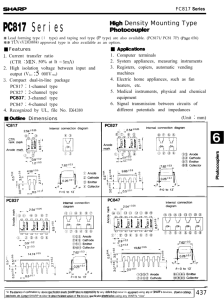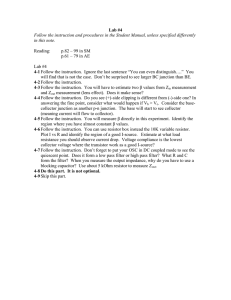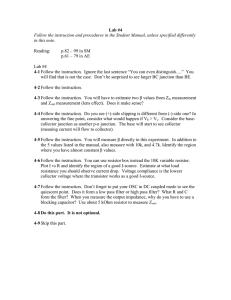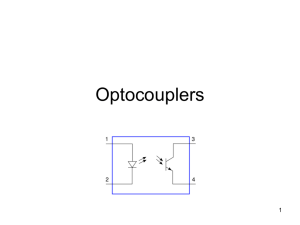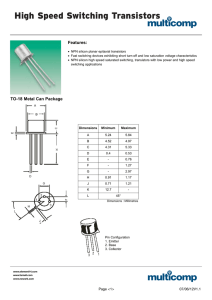Design Guideline for a Renesas/CEL Optocoupler
advertisement
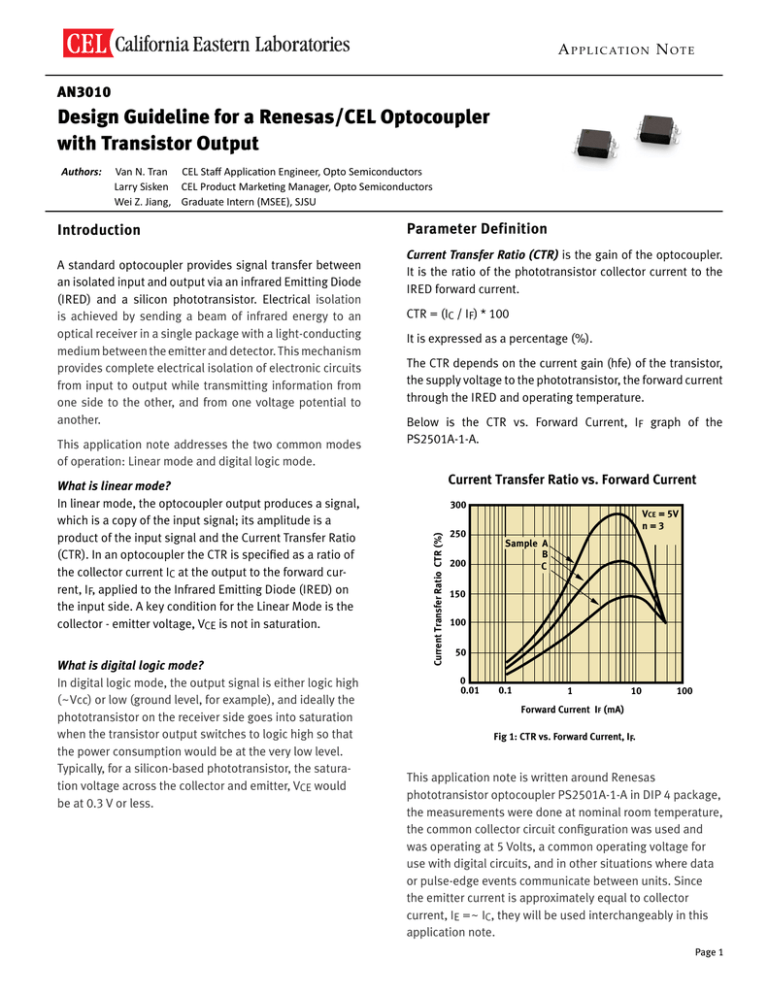
A p p l i c at i o n N o t e AN3010 Design Guideline for a Renesas/CEL Optocoupler with Transistor Output Authors: Van N. Tran CEL Staff Application Engineer, Opto Semiconductors Larry Sisken CEL Product Marketing Manager, Opto Semiconductors Wei Z. Jiang, Graduate Intern (MSEE), SJSU A standard optocoupler provides signal transfer between an isolated input and output via an infrared Emitting Diode (IRED) and a silicon phototransistor. Electrical isolation is achieved by sending a beam of infrared energy to an optical receiver in a single package with a light-conducting medium between the emitter and detector. This mechanism provides complete electrical isolation of electronic circuits from input to output while transmitting information from one side to the other, and from one voltage potential to another. This application note addresses the two common modes of operation: Linear mode and digital logic mode. What is linear mode? In linear mode, the optocoupler output produces a signal, which is a copy of the input signal; its amplitude is a product of the input signal and the Current Transfer Ratio (CTR). In an optocoupler the CTR is specified as a ratio of the collector current IC at the output to the forward current, IF, applied to the Infrared Emitting Diode (IRED) on the input side. A key condition for the Linear Mode is the collector - emitter voltage, VCE is not in saturation. What is digital logic mode? In digital logic mode, the output signal is either logic high (~Vcc) or low (ground level, for example), and ideally the phototransistor on the receiver side goes into saturation when the transistor output switches to logic high so that the power consumption would be at the very low level. Typically, for a silicon-based phototransistor, the saturation voltage across the collector and emitter, VCE would be at 0.3 V or less. Parameter Definition Current Transfer Ratio (CTR) is the gain of the optocoupler. It is the ratio of the phototransistor collector current to the IRED forward current. CTR = (IC / IF) * 100 It is expressed as a percentage (%). The CTR depends on the current gain (hfe) of the transistor, the supply voltage to the phototransistor, the forward current through the IRED and operating temperature. Below is the CTR vs. Forward Current, I F graph of the PS2501A-1-A. Current Transfer Ratio vs. Forward Current 300 Current Transfer Ratio CTR (%) Introduction 250 200 VCE = 5V n=3 Sample A B C 150 100 50 0 0.01 0.1 1 10 100 Forward Current IF (mA) Fig 1: CTR vs. Forward Current, IF. This application note is written around Renesas phototransistor optocoupler PS2501A-1-A in DIP 4 package, the measurements were done at nominal room temperature, the common collector circuit configuration was used and was operating at 5 Volts, a common operating voltage for use with digital circuits, and in other situations where data or pulse-edge events communicate between units. Since the emitter current is approximately equal to collector current, IE =~ IC, they will be used interchangeably in this application note. Page 1 AN3010 Linear Mode Operation IF VCC VIN IC VCE vs. Forward Current, IF 6 5 VCE (V) In the common collector configuration (see figure 2.0), the collector is the common point of this transistor circuit, and the output is taken at the emitter. The output transitions from a low state to a high state when the optocoupler input transitions high. 4 RL = 100 OHM 3 RL = 320 OHM 2 RL = 470 OHM 1 0 0 5 10 15 20 25 30 Forward Current, IF (mA) VOUT Rin RL Fig 3.0: Collector-Emitter Voltage vs. Forward current at different load resistors Common Collector Amplifier Fig 2.0: Common Collector Amplifier In general, choose the load resistor RL, to make sure that Vcc – (IE *RL) > 0.7V Where, IE is the emitter current through load resistor RL. To work effectively in the linear mode, RL should be around 470Ω or less, depending on the drive current IF and the design objective. To show how the forward current, I F, and load resistor, RL, affect the collector-emitter voltage VCE, and emitter current IE, data was collected and is shown in figures 3.0 and 4.0 for reference. From these graphs, we can see that the load resistor RL at 470Ω would limit the linear operating region of the forward current, IF to around 6mA or less. In comparison, the load resistor value of 100Ω would extend the linear operating region up to 12mA. Note that the values for VCE do not go below about 2.7V. A resistor value somewhere between 100Ω and 320Ω would provide a linear range of VCE values with different slope. Figure 4.0 shows a fairly linear range of collector current IC with the 100Ω resistor value. Depending on the desired goal, various resistor values provide the desired results. 25.00 25 Emitter Current, IE (mA) The output voltage is at the load resistor between the emitter pin and ground. Emitter Current, IE, vs. Forward current IF RL = 100 OHM 20.00 20 15.00 15 RL = 320 OHM 10.00 10 RL = 470 OHM 5.00 5 0.00 0 0 5 10 15 20 25 30 Forward Current, IF (mA) Fig 4.0: Emitter Current vs. Forward Current at different load resistors Digital Logic Mode Option without using CTR To operate in the digital logic mode, we plan for the optocoupler output transistor to operate in saturation mode. First, review the Renesas optocoupler datasheet for values useful in calculating circuit values at the input and output. Our example uses graphs and information from the PS2501A1-A data sheet as shown in figure 5.0 Figure 5.0 shows the Collector Current vs. Collector Saturation Voltage. The collector current shown is developed from the input forward current IF and CTR value for the selected optocoupler. Page 2 AN3010 Collector Current vs. Collector Saturation Voltage 10 Figureapplications 4.0: Optocouplers to drive discrete components forforward motor Some mayused be required to tolerate higher drive application. current, IF, such as, 10 mA, for example. IF= 10 mA Collector Current IC (mA) IF= 5 mA IF= 2 mA IC = 2.0 mA IF= 1 mA 1 IC = 0.7 mA IC = 0.5 mA 0.1 0 0.2 0.4 0.6 Note that a load resistor change from RL = 13kΩ to 3.3kΩ would improve the switching time, such as, rise and fall time as shown in table 2.2 below. 1.0 0.8 The option is either to keep the same load resistor, RL, at 13kΩ or choose the Ic = 2.0 mA as shown in figure 5.0, then select the RL, so the product of (RL * IC) > 5V. In this example, select any resistance value of 2.5kΩ *1.3 or greater. In this example, 3.3kΩ would be sufficient. Collector Saturation Voltage VCE(sat) (V) CTR = 140% @ VCC = 5V, IF = 5mA Fig 5.0: Collector Current vs. Collector Saturation Voltage The simple approach to operating the phototransistor in saturation mode is by selecting the constant collector current at 0.5mA as shown in figure 5.0, so that VCE is at 0.2V or less. Note that one could select Ic = 0.7mA and VCE = 0.2V with an input current of IF = 1mA. However, in the example, Ic = 0.5mA is selected as a demonstration. IF (mA) RL (KΩ) tr (us) tf (us) 1 10 13.0 3.3 22.5 8.5 82.5 28.0 However, there is a trade-off between high input current and the degradation of an optocoupler over the lifetime. Option with CTR Calculate the RL : In some instances, when the designers prefer to use opto device with a specific rank for the digital mode to switch it ON or OFF. RL=(Vcc - VCE )/0.5mA = (5V-0.2V)/0.5mA =9.6kΩ. There are two things must be observed: In practice, RL should be chosen with additional 30% tolerance or more, so by selecting RL = 13.0kΩ as a standard value, it would be sufficient. Design based on the worst-case scenario Next, what is the forward current needed to achieve the desired result? Key goals of the design are to achieve a long service lifetime for the device and to operate at low power consumption. Choose the forward current IF between 1.0 to 3.0 mA as shown in figure 5.0 since further increase of IF will not make any significant difference in the output, Vout, and higher input drive does not drive the saturation voltage lower. Data is collected in table 1.0 for reference. RL = 11.0 KΩ Forward Current, IF ( mA) 1 2 3 4 5 6 VOUT (V) VCE (V) IE (mA) 4.88 4.89 4.89 4.91 4.95 4.96 0.12 0.11 0.11 0.09 0.05 0.04 0.452 0.453 0.453 0.455 0.458 0.459 In other words, design it based on the low end of the CTR rank. For example, if the PS2501A-1-Q-A is used. From the data sheet, the “Q” rank shows that the CTR = 100% to 200% at LED forward current, IF = 5mA, then use the CTR = 100% at IF = 5mA as the reference point for the design and the same forward current, IF = 5.0mA must be used. Other forward currents that are different from IF = 5mA would produce different sets of CTR graphs as shown in figure 1.0. Calculate Load Resistance, RL By using the same configuration as shown in figure 2.0 as an example, calculate RL as follows: RL_calculated = (Vcc – 0.2V) / (5mA * Lower limit of CTR rank) And select RL_actual > = 2 * RL_calculated For example, assume Vcc=5V, IF = 5mA and PS2501A-1-Q is used, then RL_calculated = (5V - 0.2V)/5mA)=960Ω And RL_actual = 2.0kΩ Table 1.0: Forward Current, IF vs. Vout Page 3 AN3010 To set the forward current, IF of the IRED The input resistor to set the forward current, IF is calculated: Rin = (Vin – VF)/ IF (Refer to Figure 2.0) Find the value for VF from the graph in figure 6.0. This will not be exact, and a nominal value will work. For the IF = 5.0mA, we can select VF = 1.15V and Vin = 5V at a temperature of 25°C from figure 6.0 as a reference: Rin = (5.0V – 1.15V) / 5mA = 770Ω, so choose the standard value of 750Ω or less. Forward Current vs. Forward Voltage 100 Forward Current I F (mA) 50 TA = +100˚C +60˚C +25˚C 10 5 0˚C –25˚C –50˚C 1 0.5 0.1 0.7 0.8 0.9 1.0 1.1 1.2 1.3 1.4 1.5 Forward Voltage VF (V) Figure 6. Forward Voltage vs. Forward Current Conclusion This application note uses the PS2501A-1-A as an example to provide a general design guideline or a general reference that applies to other Renesas/CEL optocoupler products to meet a specific design need in either the linear mode or digital logic mode. However, take note on the dynamic relationship between IF, CTR, Vcc, RL, operating temperature and lifetime that interact with one another. Also, refer to AN 3009 Phototransistor Switching Time Analysis for more information on improving switching time for an optocoupler. Information and data presented here is subject to change without notice. California Eastern Laboratories assumes no responsibility for the use of any circuits described herein and makes no representations or warranties, expressed or implied, that such circuits are free from patent infringement. © California Eastern Laboratories 09/10 4590 Patrick Henry Drive, Santa Clara, CA 95054-1817 Tel. 408-919-2500 FAX 408-988-0279 www.cel.com Page 4
